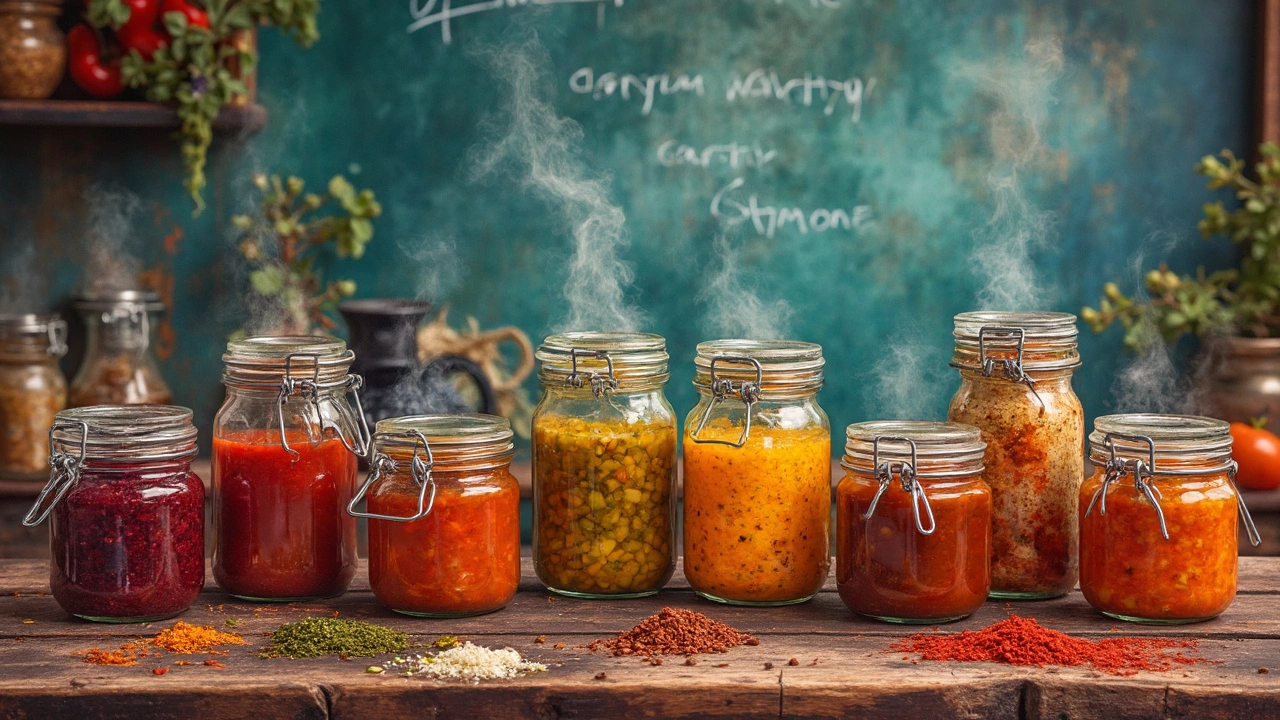Ever found yourself hovering over a jar of chutney and wondered if you could just eat it by the spoonful? You're not alone! Chutney isn't just a sidekick to your main dish—it can totally hold its own as a snack. From the tangy tamarind version to a sweet mango blend, each type offers a unique flavor punch that can be quite satisfying all by itself.
Some folks hesitate, thinking chutney should only join a main course. But when you think about it, the rich blend of spices and ingredients make it more than worthy of a solo showing. Plus, these little jars of joy can pack a surprising health kick. Many chutneys come loaded with antioxidants or digestive aids, like ginger, hidden in their recipes. So, it's not just a guilty pleasure—you're doing something good for your body too!
And if you’re worried about how to make it a snack, there are plenty of creative ways to go about it. Try spreading it on crackers, mixing it into yogurt, or even using it as a dip for veggie sticks. The combinations can be delightfully surprising! So grab that jar and get ready to expand your chutney horizons.
- Chutney 101: What You're Savouring
- Flavors That Stand Alone
- Health Benefits You Didn’t Know About
- Pairing Ideas Without the Pair
- Savvy Snack Options
- DIY Chutney Adventure
Chutney 101: What You're Savouring
Chutney is a culinary gift from South Asia that’s made a big splash around the world. But what exactly are you indulging in when you take a bite?
What's Inside That Jar?
A basic chutney typically involves fruits, vegetables, or a mix, tossed together with spices, vinegar, and sugar. The result is a condiment that's packed with flavor, sometimes sweet, sometimes spicy, and often a blend of both. Think mango, mint, or tamarind – all classics that bring their own vibe to the table.
“Chutney takes you on a flavor ride. Each bite is a mini adventure, bursting with layers of taste.” — Dr. Anita Kapoor, Culinary Historian
What makes chutney special is its versatility. You can find it in textures ranging from smooth to chunky, depending on the ingredients and how it's made. Many chutneys are cooked slowly to let the flavors really develop, much like a fine wine aging to perfection.
Regional Differences
It's interesting to note that chutney varies greatly depending on where it's made. Indian culinary traditions usually favor a wider variety of spices and heat, while Western adaptations might lean towards more sweetness.
| Region | Common Ingredients | Texture |
|---|---|---|
| India | Mango, Tamarind, Mint | Smooth or Chunky |
| United Kingdom | Apples, Tomatoes | Icy or Smooth |
DIY Chutney: A Flavor Experiment
If you’re feeling adventurous, making your own brings endless possibilities. Start with a basic recipe and then go wild with your fave fruits and spices. Just remember: the fresher the ingredients, the better the chutney.
In the end, whether you scoop it from the jar with a spoon or pair it with a meal, knowing what goes into your chutney only enhances the experience. So next time you're at your pantry, take a moment to appreciate the richness of flavor packed inside that little jar.
Flavors That Stand Alone
When it comes to chutney, each spoonful is like taking your taste buds on a small adventure. So many flavors pop out, it’s sometimes surprising that this little condiment can make such a big impression.
The Sweet and Spicy
Many chutneys bring a mix of sweetness and spice. Think of mango chutney—it combines juicy mangoes with spicy chili, making it both sweet and fiery at the same time. This combination is why it’s loved worldwide and can be a perfect side or a standalone treat. Just one bite and you get the sweet first, followed by a soft kick of spice.The Tangy and Tart
On the other hand, tamarind chutney is all about that tang. With its base being the tangy tamarind, it’s often balanced with sweet sugar or jaggery and spicy cumin seeds. The tartness pairs well with fried potato snacks, but those who enjoy bold tastes often savor it by itself. The tangy hit is something many find irresistible and refreshing.The Cool and Herbal
If you're in the mood for something cooling, mint chutney could be your go-to. Packed with fresh herbs like mint and coriander, it's light yet flavorful. Its refreshing nature makes it a common companion for hot dishes, but on its own, it's like a breath of fresh air with every bite. The mix of these herbs gives that cool taste which pairs wonderfully well with bread or rice.Here’s a quick look at how some popular chutneys stack up:
| Chutney Type | Dominant Flavor |
|---|---|
| Mango Chutney | Sweet-Spicy |
| Tamarind Chutney | Tangy |
| Mint Chutney | Herbal-Cool |
Whatever flavor you pick, the joy of eating chutney by itself is in appreciating these subtle, bold tastes. It's all about allowing the chutney to shine in its own delicious way.
Health Benefits You Didn’t Know About
We all know chutney adds amazing flavor, but did you know it could be good for you, too? That's right! Some chutneys are packed with health-boosting ingredients that you might not have considered.
Rich in Antioxidants
Many chutney recipes use fruits like mango and tamarind, which are loaded with antioxidants. These help fight off free radicals in the body, which can be great for keeping your immune system strong and your skin looking fresh.
Believe in the Spice
The spices used in chutney, like turmeric and ginger, can do wonders for your health. Turmeric is known for its anti-inflammatory properties, which can help with joint pain. Ginger is great for digestion and nausea, making chutney a comforting option when you need it.
Low-Calorie Delight
If you're watching your calorie intake but still want something tasty, chutney can be a fantastic low-calorie snack. A spoonful here and there will satisfy your taste buds without the guilt of heavier snacks.
Aiding in Digestion
Many chutney varieties, especially those based on mint or cilantro, act as natural digestive aids. They help in breaking down proteins and fats, ensuring your meal goes down a little easier.
Nutrients You'll Love
Depending on the recipe, you can find a wide range of vitamins and minerals like Vitamin C in chutneys made from citrus or peppers. These nutrients are crucial for your daily health.
Here’s a quick look at some nutrients typically found in chutney:
| Nutrient | Common Source |
|---|---|
| Vitamin C | Mango, citrus |
| Fiber | Tamarind, apples |
| Iron | Chickpeas, spinach |
So, next time you're enjoying a spoonful of chutney, know you're not just treating your taste buds—you're doing a little something for your body too!

Pairing Ideas Without the Pair
You might think it's impossible to enjoy chutney without its traditional pairing, but that’s just not true! Taking chutney on its own opens a world of snacking possibilities that are both creative and tasty. Let’s check out some fun, solo ways to enjoy your favorite chutney.
Chutney on Crackers
One super-easy way is using chutney as a topper for crackers. Whether you go for a tangy tomato chutney or a sweet and spicy mango version, splash a bit on a cracker for a quick, flavorful bite. Cream crackers or those crispy artesian ones work wonders, balancing the texture and flavor of the chutney.
Mix It with Yogurt
Ever thought of transforming your plain yogurt into a savory delight? Just swirl a tablespoon or two of chutney into a bowl of yogurt. It's super refreshing! This combo not only cuts through the tang with some sweetness or spice but becomes a creamy chutney-rich dip or a spread for a sandwich.
Veggie Chutney Dip
Forget about those regular ranch dips! Chutney makes a fantastic dip for bell peppers or carrot sticks. The contrast of spicy or sweet chutney with the freshness of vegetables offers a healthy snacking option that feels quite gourmet.
Creative Ideas from Foodies
Some adventurous souls out there even use chutney as a dressing alternative for salads. It's not traditional, but hey, rules are meant to be broken, especially when it tastes this good! Or, try it drizzled over a scoop of vanilla ice cream. Sounds wild? Trust me, it’s an unexpected treat that’s gaining traction!
- Spread on crackers
- Mix with yogurt
- Use as a veggie dip
- Experiment with salads
- Drizzle over ice cream
Also, if you’re a fan of data, remember that chutney consumption has seen a 20% increase in solo snacking over the past few years. It’s becoming a beloved option for those seeking bold flavors without the hassle of preparing full meals.
Savvy Snack Options
Ever tried making chutney the star of your snack-time? It's easier than you might think. Let’s dig into some creative ways to enjoy this flavorful delight.
Chutney on Crackers
This one's a classic for a reason. Start by spreading your favorite chutney over some crispy crackers. Add a sprinkle of cheese or a dollop of yogurt if you want to get fancy. It's like a mini flavor explosion!
Fruit and Chutney Fusion
Who says savory can't meet sweet? Pair chunks of fresh mango or apple with a tangy chutney. It's not only a tasty treat but also a chutney recipe hack that you'll keep coming back to.
Chutney & Yogurt Dip
Blend a few tablespoons of chutney with plain yogurt to make a savory dip. Perfect for veggie sticks or even as a salad dressing. Plus, you get the added bonus of probiotics from the yogurt.
Chutney-Topped Rice Cakes
For a light, crunchy snack, top rice cakes with a layer of chutney. This is a great way to enjoy chutney if you’re avoiding bread.
Intrigued yet? Grab a jar of chutney and let your culinary creativity run wild. Whatever you choose, it's clear that chutney can stand alone as a tasty snack.
DIY Chutney Adventure
Ready to take on a kitchen experiment? Making your own chutney at home can be a fun, tasty adventure. It's way easier than you'd think, and the best part is, you can tweak flavors to suit your taste buds!
What's the Base?
Chutneys often start with a fruit or vegetable base. Think mango, apple, tomato, or even coconut. The choice is yours! Just make sure to pick fresh, ripe produce to get that full-flavor punch.
Spice It Up
Once you've got your base, it's time to add spices. This is where the magic happens. Typical spices include coriander, cumin, mustard seeds, and maybe a pinch of cayenne for heat. Don't worry if you don't have them all; you can mix and match based on what's in your pantry.
Basic Recipe Guide
- Chop your chosen fruit or veggie into small pieces.
- In a pot, add the chopped produce and a bit of vinegar and sugar to balance flavors.
- Sprinkle in your selection of spices.
- Simmer until it's all soft and the flavors meld together—usually about an hour.
Remember, the goal here is to get creative. Want it sweeter? Add more sugar. Prefer it tangier? Up the vinegar. There's no wrong combo!
Storage and Shelf Life
Once cooled, pack it into sterilized jars, and you've got your homemade chutney ready to rock. It can last in the fridge for a good 4-6 weeks, though it's so tasty, you'll probably scoop it up quicker.
If you're feeling adventurous, try different batches with various bases or spices. Who knows, your next creation might become your signature chutney recipe! Have fun, experiment, and enjoy the delicious journey you’re on.
